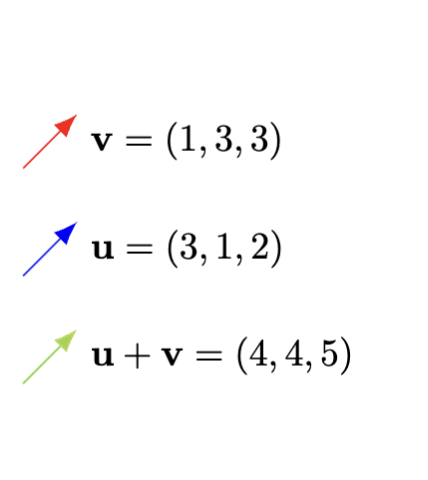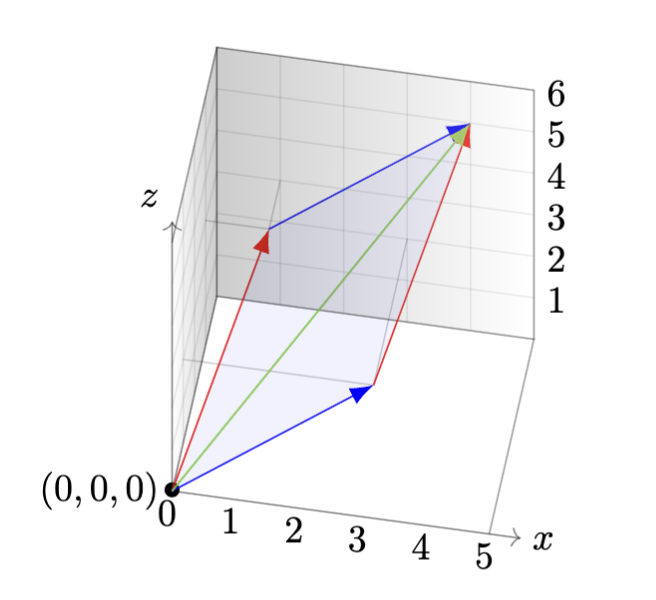#concept-pamphlet #todo: fill with the things that interest me
Notes
Scaffold
- Geometry of vectors and projections
- Multivariate functions and optimizations
- Geometry and algebra of matrices
- Matrix algebra and linear systems
- Eigenvalues and second partial derivatives
- Pagerank
- Neural networks and multivariable Chain rule
Intro
a theorem in mathematics does not become ___ later on as new ideas are discovered.
?
false
math51book, page 7
read
as ? “the set of all triples (x,y,z) of real numbers” math51book, page 8
read
as ? ‘is in’, ‘is an element of’, ‘belongs to’ read
or
as ‘for which’, ‘such that’
Part I. Geometry of vectors and projections (1-7)
ch 1
Notation
? Set of all n-vectors
? length or magnitude of an n-vector v
scalar ? a real number visualize 2 n-vectors being added, notation-wise ?
visualize the shapes of a linear combination ?
for given n-vectors
and scalars
result is n-vector of form
Imagine these vectors being added together in geometric space 💛
 ?
?

convex combination
length
unit vector
ch2
correlation coefficient r ? cosine of angle between X and Y … remember the acronym for sine, cosine, tan? >> SOHCAHTOA cosine formula ?
length via dot product
properties of dot products
verify orthogonality for two n-vectors
ch3 points&planessss
ch4 spansslinear subspace 😌 dims
ch5 A collection of vectors in is called orthogonal if ?
visualize geometrically, 2 orthogonal vectors in ? when you look at the plane that the 2 vectors are both on, there’s a 90 degree angle (but like…why????? why does this happennnn with dot product) A collection of vectors in is called orthonormal if ? they are orthogonal to each other and are all unit vectors. That is, for all
vectors planes in R^3 orthogonality projections linear regression
Part II. Multivariate functions and optimizations (8-12)
- countour plots
- partial derivatives
- gradients
- gradient descent
- lagrange multipliers
- applications
- linear programming
Part III. Geometry and algebra of matrices (13-18)
- derivative matrix
- linear function
- affine function
- matrix multiplication
- markov chains
- matrix algebra applications
- multivariable chain rule
- matrix inverses
- matrix transpose
- orthogonal
Part IV. Matrix Algebra and linear systems (19-22)
-
linear independent
-
gram-schmidt process
-
orthogonal matrices
-
null space
-
matrix decompositions
-
linear systems
-
quadratic form
-
qr decomp
-
lu decomp
-
hessian
-
singular value comp
Part V. Eigenvalues and second partial derivatives (23-27)
- eigenvalues
- eigenvectors
- higher partial derivatives
- applications of eigenvalues
- singular value decomposition
Part VI. Pagerank
how it works
Part VII. Neural networks and multivariate chain rule
a specific example
Part VIII. Cross product
Part IX. QR algorithm
Notation
Concept
Result
why linear algebra math is important
- google page rank was combo of eigenvalues and markov chains applied to n-dimensional spaces with N on the order of billions (total number of webpages on the internet)
meta of reading this book
- blue box = core math concept. don’t skip
- end of each chapter = 1 page summary
- theorem = labeled as such
theorem - mathematical fact which has been proven true
- use special cases and low-dimensional pictures to remember things. Remembering an idea or a visualization is often easier than memorizing a formula, and is a more reliable kind of knowledge.
- definitions are absolutely crucial in mathematics.
- Build up understanding of ideas first in a special case before the general case. After class, read about the material in the book, reread things multiple times, and look through the highlight sum- mary at the end of the chapter. After reading the statement of a result, work out what it is saying in some special cases (e.g., low dimensions, three vectors instead of k vectors, etc.).
- Math can only be learned actively. There is almost no value to looking over notes (or a textbook, or watching a video) and thinking “oh, I can do that; it makes sense”. Watching someone else do a problem, or reading a solution, is wildly different than facing the problem on a blank sheet of paper. One can’t learn to swim by just reading a book, or learn to build a tiled hut from sticks and stones just by watching this video, and likewise math cannot be learned by only watching others do it. In math, all reading must be done with paper and pen/pencil in hand. Instead of just reading worked examples, actively write out solutions on your own.
- Do not blindly memorize things! If the motivation for a definition or the meaning of a result or method is ub. nclear, ask about it.
Two guiding principles in the writing of this book were to give (i) concrete definitions and numer- ical experience before more conceptual perspectives (without diminishing the importance of the latter), (ii) concepts, techniques, and results that are applicable uniformly to R^n for all n (important for many contemporary applications of linear algebra and multivariable optimization across many fields)